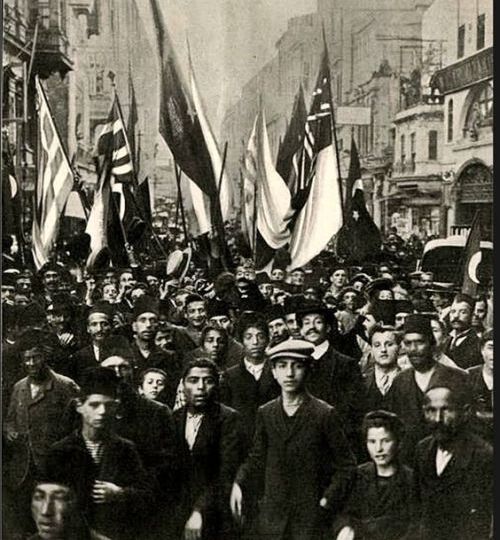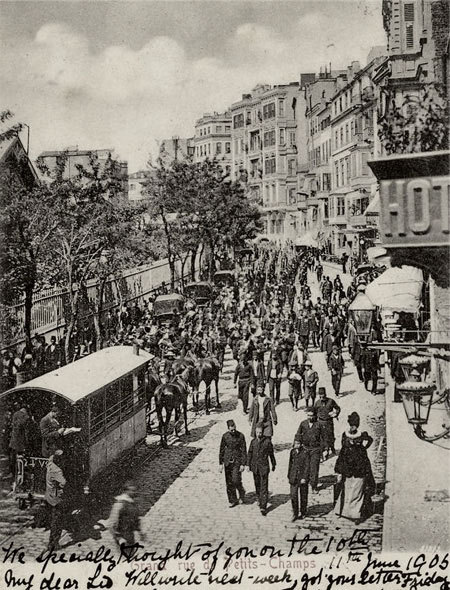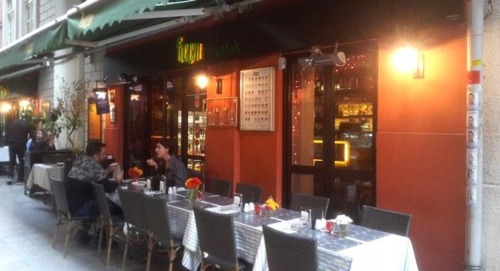
In 1910, some of the residents and shop owners of Glavany Street in Beyoğlu (today’s Kallavi Street) submitted a petition to the Department of Public Security, the new police institution established after the adoption of the Second Constitution in 1908. Among them were six tailors, a shoemaker, three barbers, three cooks, two restaurant owners, a baker, a tobacco seller, two doctors, a dentist, and a merchant. The petitioners, most of them Armenian and Greek men, complained that three properties on the street had been rented by women who were operating brothels in these buildings under the guise of hotels. They requested the police to close down the brothels on “their street,” and remove the “immoral” women working there. The petition began as follows: “In the blessed period of the Constitution, the efforts for ensuring the comfort and improving the morals of the people are well-known and appreciated by all. Thus, we dare to report a repulsive situation that is contrary to the measures taken by the government in this respect.” The petitioners then listed their specific complaints about the situation: that the prostitutes working in these brothels solicited men in the street, swore, threw soiled items out of their windows, took in and let out their clients carelessly and shamelessly, openly indulged in all kinds of vice, and insulted their neighbors. The Glavany residents’ petition was only one of many of its kind at the time. In the first decades of the twentieth century, many residents of the neighborhood submitted similar petitions to the police, requesting the displacement of prostitutes occupying “their streets.” Petitioners consistently complained about noise, non-stop music, and crowds loitering in the area, blaming prostitutes as the main cause of these problems. These petitions kept me enthralled, revealing a lively drama through which contested and conflicting claims about space, identity, gender, personal rights, and citizenship played out in the hindsight.
As I spent my days tracing such documents in the Ottoman Archives in preparation for my dissertation proposal, I lived in Beyoğlu. At the time, I was pregnant with my first child, diligently pursuing a healthy diet, the reason that a particular ecologically-friendly health food grocer in Kallavi Street was one of my favorite spots in the neighborhood. During one of my visits to this shop, I suddenly realized that the Glavany Street mentioned in one of the documents I was researching was none other than Kallavi Street, where I then stood inquiring at the grocery store about the availability of free-range, organic eggs. I remember a particularly intense sense of immanence and unity coursing through my body, like I was part of an unfolding history of the street itself. While my mind was struck with the awareness of the lost voices of the lovely, “immoral” women of the street’s past, another kind of bodily experience, rooted in the space itself, was connecting me to their world.
The story of the name of the street reveals another set of claims on space and identity. The street was named Glavany after a powerful Levantine family who once lived in the area. The Glavany family migrated to Beyoğlu from Chios in the mid-nineteenth century. They built their first house, a wooden mansion, in one of the streets that connected Grand Rue de Pera (today’s İstiklal Street) to Tepebaşı. Soon after, the street became known as Glavany Street. Through the second half of the nineteenth century, the family commissioned some important buildings in Beyoğlu such as Glavany Apartments in Postacılar Street and the Ottoman Bank in Voyvoda Street. However, just like the Buddenbrooks in Thomas Mann’s eponymous novel, the fortunes of the Glavany family began to decline soon after they built their flamboyant residences and offices in Beyoğlu. At the end of the nineteenth century, the family lost its prominence in the social and economic landscape of the district, and their name would only survive for a few more decades.

Street scene from Tepebaşı at one end of Glavany Street, early twentieth century.
Less than fifteen years after the middle class male residents of Glavany Street submitted their petition demanding the removal of their supposedly immoral female neighbors, the men themselves, the women they complained about, and hundreds of thousands of men and women all around the country were brutally displaced from their homes, streets, and lands. If they were lucky enough to remain, their claim to spaces and identity was silenced. The very names of their streets, villages, towns, and cities were purged to hide and forget the multiethnic and multilingual past of the country. Glavany Street became Kallavi Street, by design a name cleansed of memory and emotions.
Today, among the buildings on this street there is a Circassian restaurant, Fıccın. The owner is likely a descendent of Circassian refugees, themselves forced to migrate to Ottoman lands as a result of nineteenth century wars and conflicts in the Caucuses. Some of the waiters at Fıccın are migrant laborers from Turkic Countries. On Kallavi’s street corners, Syrian refugee kids and young Kurdish street musicians are always present. Aren’t all these too much for this narrow, shadowy street to bear?, I sometimes wonder, with mixed feelings of amazement, nostalgia, and soreness.
This year, when I returned to the district as an ANAMED fellow, Glavany Street again became central to my Beyoğlu experience. The residential fellows in ANAMED frequently lunch at Fıccın. In this sense, the street functions as a natural extension of ANAMED. I find it ironic and joyful that my ANAMED friends refer to the street as “Fıccın Street.” They neither know about the once-so-powerful Glavany family, nor submit to the mono-linguistic claims of its official name. They name it according to their own personal everyday experiences.

Street scene from today’s Kallavi Street.
That is what I find most exciting about mundane everyday life: that in everydayness, oppressive, moldy ways of thinking and speaking are broken apart, clearing a path for imagination to wander and for new potentialities to take root. This is the reason I keep turning back to the everydayness of the past, to research. I try to find out which buildings the women that petitioners complained about lived and worked. I wonder in which languages they swore at and insulted their self determinedly “respectable” neighbors. But were these relationships so tense all the time? Did they “only” quarrel with each other? Didn’t the “prostitutes” buy their breads and tobacco from the shops of the men who complained about them? Did they exchange any smiles while passing each other on the street where they all lived? Were some of the petitioners also the customers, friends, and lovers of the women they complained about? Today, I can only speculate about these things. Poor, “immoral” women rarely leave us ego documents.
Still, speculating about the everyday lives of Glavany Street provides a possibility for speculating about/imagining better pasts and better futures. Like most of the streets of Beyoğlu, Glavany brings together groups and categories which are considered exclusive of each other. For example, the experiences of the multi-national ANAMED researchers/fellow in search of the lost times of these lands and mostly desperate young people from far corners of giant Istanbul intersect in the nights of Nur-u Ziya Street, if only when sleep evades the former because the latter dance to the never-changing rhythms of Turkish pop playlists into the late hours. In the past and present of these streets, one can always hear diverse claims, voices, and languages. And one can always speculate that in the endless potentialities of everyday life these claims, voices, and languages could/can interact in ways to break down conventions and enable genuine dialogue. Here, we can come together to celebrate the repressed voices of the past and enjoy the diversity and potentialities of present everydayness!

